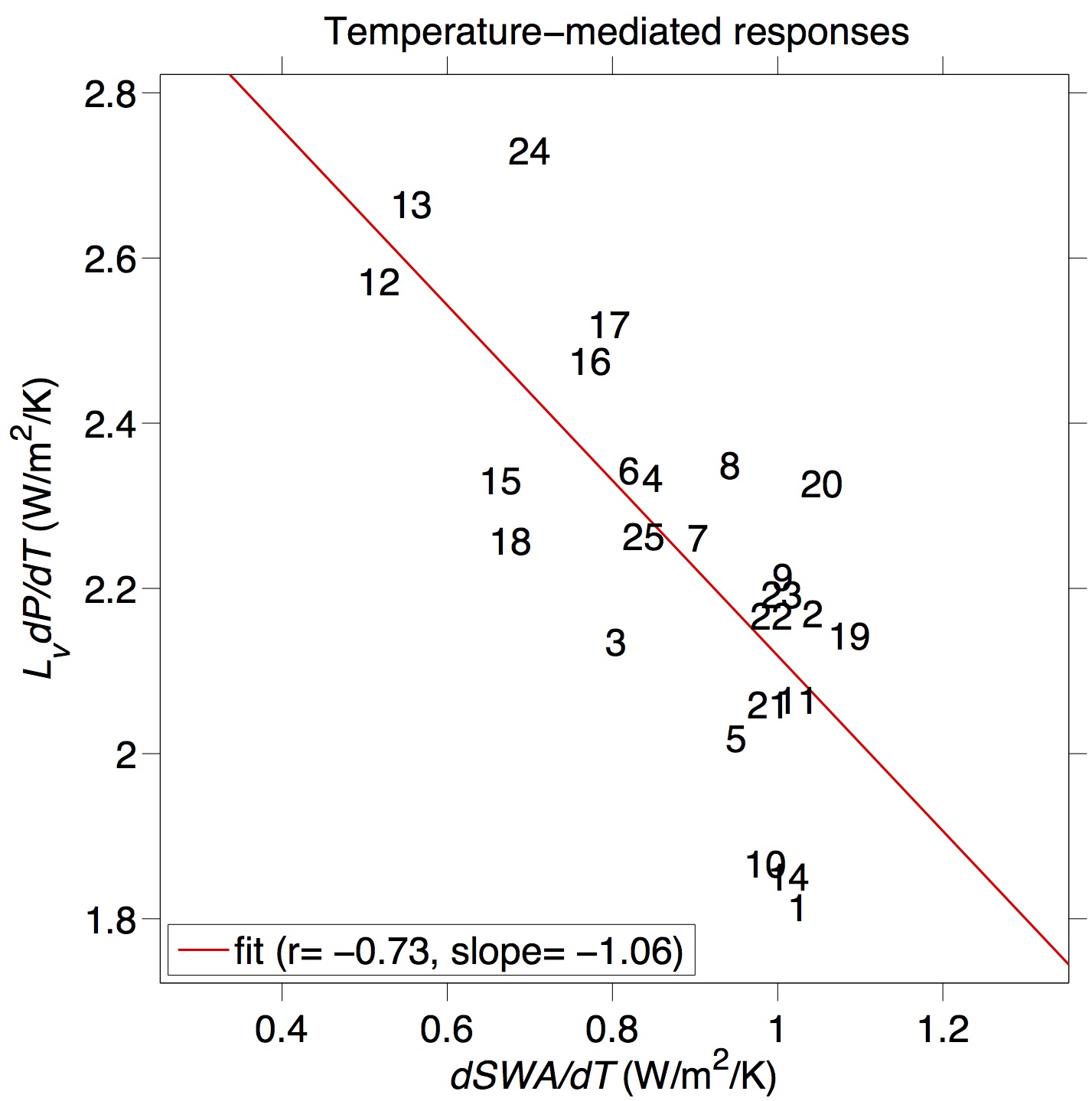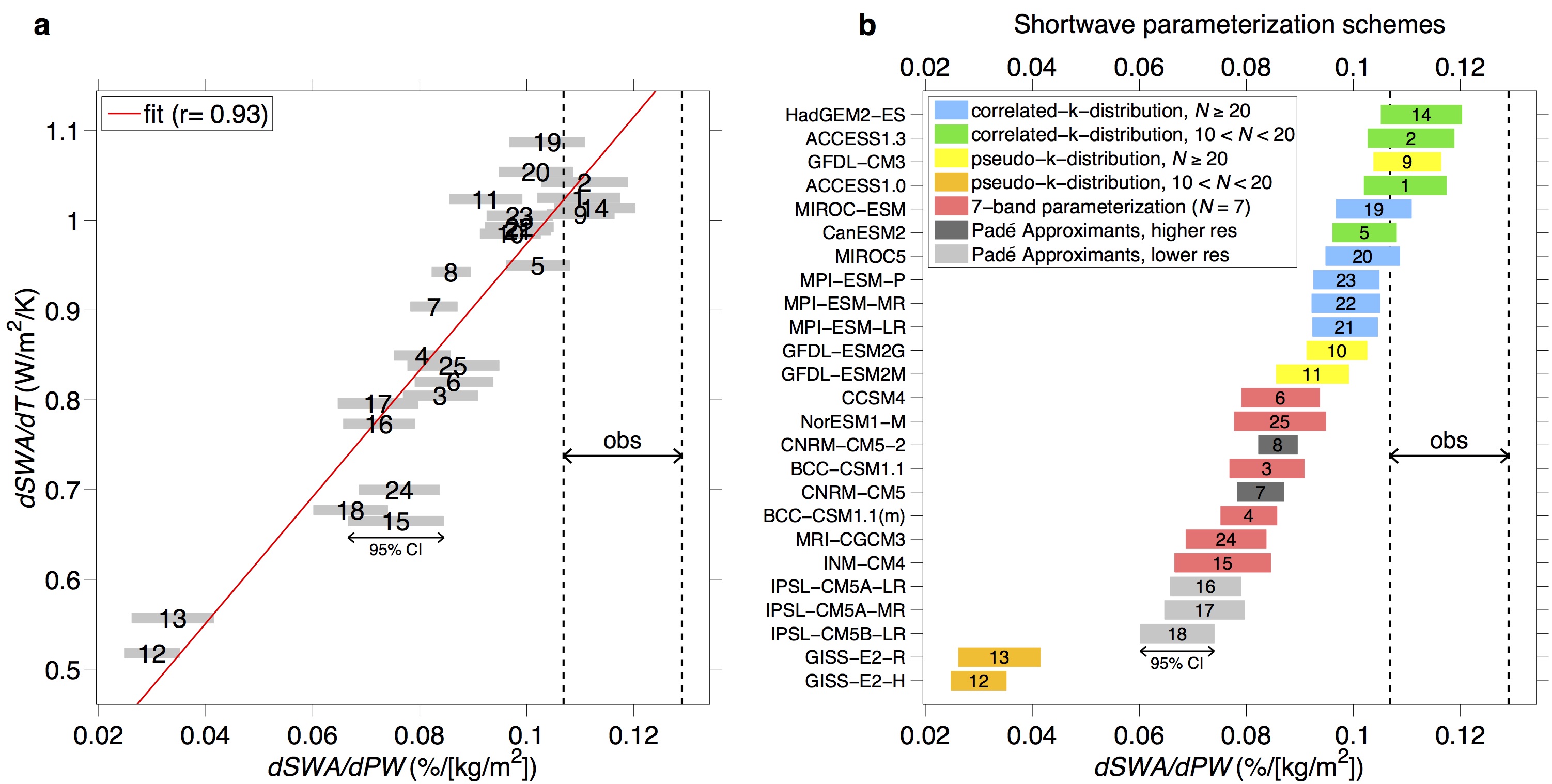
|
||||||||||||||||
|

Climate Feedbacks and Emergent Constraints An observational radiative constraint on hydrologic cycle intensificationIntensification of the hydrologic cycle is a key dimension of climate change that may have severe impacts on human and natural systems. A basic indicator of hydrologic cycle intensification—the increase in global-mean precipitation per unit surface warming—varies by a factor of three in current-generation climate models, and the sources of this spread remain poorly understood. As global-mean precipitation is constrained by the atmospheric energy budget, the spread is likely tied to differences in how net radiative cooling of the atmosphere (contributed by longwave and shortwave radiation) and surface sensible heat flux respond to climate change. We seek to untangle the cross-model relationships between the responses of these energy budget components and global precipitation under greenhouse-gas-induced climate change. In 25 models participating in phase 5 of the Coupled Model Intercomparison Project (CMIP5), we analyze the rapid adjustments and surface-warming-induced (hereafter, temperature-mediated) responses of the atmospheric energy budget components following an abrupt increase in atmospheric carbon dioxide (CO2). The analysis reveals that model spread in the temperature-mediated increase in global precipitation, which significantly contributes to spread in the total precipitation increase, can be explained to a large extent by model differences in the warming-induced increase of atmospheric shortwave absorption. Specifically, the intermodel correlation coefficient between the temperature-mediated response of precipitation and shortwave absorption is –0.73 (Fig. 1). In other words, models with larger increases in shortwave absorption tend to have smaller increases in precipitation, per unit surface warming. This is because when the increase in shortwave heating is larger, a smaller increase in latent heating from precipitation is required to compensate for enhanced longwave cooling with warming. The relationship of Fig. 1 exists when shortwave absorption is computed from all-sky radiative fluxes and from clear-sky fluxes (not shown). This suggests that scatter in the shortwave absorption response originates from model differences in the increase of solar absorption by water vapor following warming-induced atmospheric moistening. In our study, we examine whether differences in the shortwave absorption response are due specifically to (1) differences in the response of water vapor for the same surface warming or (2) differences in the sensitivity of solar absorption to a unit increase in water vapor. 
Figure 1: The intermodel relationship between the temperature-mediated response of global-mean precipitation (LvdP/dT) and that of clear-sky atmospheric shortwave absorption (dSWA/dT) under CO2 forcing. Each model is identified with a number (defined in Fig. 2b). A least-squares linear fit to the scatterplot is indicated with a red line, and its statistics are given in the legend. Analysis of temperature-mediated shortwave responses estimated with radiative kernels (in which the sensitivity of solar absorption to a unit water vapor increase is effectively constant), suggests that the first possibility, the water vapor response, does not explain the spread (not shown). To test the second possibility, the sensitivity of clear-sky shortwave absorption to spatial and monthly variations of column precipitable water in the pre-industrial climate is quantified and compared with the temperature-mediated shortwave absorption response under CO2 forcing. The two quantities are highly correlated across models (Fig. 2a), suggesting that the sensitivity of solar absorption to a unit water vapor increase is the leading source of spread. Model differences in solar absorption sensitivity to water vapor stem from differences in the physical parameterizations of solar absorption by water vapor in a cloudless atmosphere (Fig. 2b). An observational estimate of the solar absorption sensitivity to water vapor is larger than that in most CMIP5 models (Fig. 2), implying that model parameterizations underestimate this sensitivity. This further implies that CMIP5 models underestimate the temperature-mediated increase of solar absorption under CO2 forcing, and as a consequence may be overestimating the increase in global-mean precipitation projected with greenhouse-gas-induced warming. A simple calculation suggests that constraining the shortwave absorption response in CMIP5 models could reduce the ensemble-mean increase in global precipitation per unit warming at the end of the 21st century by ~20%.* Improvements in shortwave radiative transfer schemes are thus critical to attain more robust projections of the hydrologic cycle. 
Figure 2: (Click to enlarge.) (a) The relationship between the temperature-mediated response of clear-sky atmospheric shortwave absorption under CO2 forcing (dSWA/dT, ordinate) and the sensitivity of solar absorption to a water vapor increase (dSWA/dPW, abscissa) across 25 CMIP5 models. A least-squares linear fit is shown. (b) The relationship between dSWA/dPW (panel a, abscissa) and the parameterization for water vapor absorption of solar radiation in a cloudless atmosphere. Each model is color coded according to the basic type of radiative transfer algorithm and corresponding number of mathematical terms implemented (N), following the legend. In both panels, the width of horizontal shading for each model represents the 95% confidence interval of dSWA/dPW. Vertical dashed lines represent statistical uncertainty in observations. Observations are based on the Clouds and the Earth’s Radiant Energy System (CERES) – Energy Balanced and Filled (EBAF) radiative fluxes and three water vapor datasets. Get the answers to frequently asked questions about this study or download the publication (DeAngelis et al. 2015) describing these results in more detail. This study was conducted as part of a joint project between UCLA and Lawrence Livermore National Laboratory, funded by the US Department of Energy. Learn more about our group's research *An earlier version of this page listed
this estimate as 40%, but 20% is the correct estimate. For
more information, see the corrigendum
to the full study.
|
|||||||||||||||
